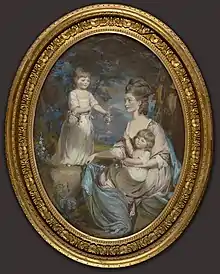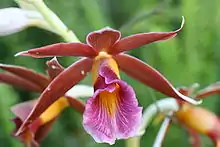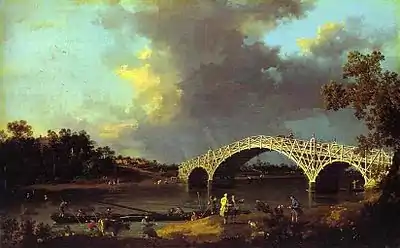Emma, Lady Tankerville
Emma Colebrooke or Emma, Lady Tankerville (1752 – 20 November 1836) was a British heiress, art patron and botanist. Lady Tankerville's collection of botanical illustrations are held at the Royal Botanic Gardens, Kew. Phaius tankerville was named in her honour by Sir Joseph Banks because it was the first tropical orchid to flower in England and it flowered in her greenhouse.
Lady Tankerville | |
|---|---|
 Lady Tankerville and her eldest daughters by Daniel Gardner | |
| Born | Emma Colebrooke 1752 |
| Died | 20 November 1836 (aged 83–84) |
| Nationality | United Kingdom of Great Britain and Ireland |
| Occupation | art patron and gardener |
| Known for | creating the first flowering tropical orchid in Britain and funding botanic art |
| Spouse(s) | Charles Bennet, 4th Earl of Tankerville |
| Children | eight |
| Parent(s) | Lady Mary (born Skyner) and Sir James Colebrooke |
Life
She was one of two daughters of Mary (born Skyner) and James Colebrooke. Her father was a member of parliament from 1751 to 1761 and the owner of Gatton Park.
She married Charles Bennet, 4th Earl of Tankerville on 7 October 1771[1] at Gatton, Surrey. He was a cricket enthusiast and a collector of shells. They would have eight children.[2] While her two eldest children were young she was painted by Daniel Gardner. The painting shows her, her two daughters, Carloline and Anna, and unusually flowers hinting at her interest in botany.[2]

She was co-heir to her father Sir John Colebrooke. She and her husband had interests in the lands and slaves on Antigua[4] and they owned agricultural land in Northumberland. They also owned a very profitable lead mine.[3] They divided their time between Chillingham Castle in Northumberland and their house Mount Felix[5] at Walton on Thames in Surrey.[3]
Lady Tankerville collected and funded hundreds of botanical illustrations. Her collection is held at the Royal Botanical gardens. Phaius tankerville was named in her honour by Sir Joseph Banks. Her Phaius tankerville was the first tropical orchid to flower in England and it flowered in her greenhouse.[6] The gardens at Mount Felix were well regarded many years after her death. It was the first tropical orchid to flower in England.[6]
In addition, their daughter Lady Mary Elizabeth Bennet (21 May 1785 to 27 Feb, 1861) worked with their gardener (William Richardson) to cultivate new strains of tri-colored viola pansy flowers[7] that were presented to the botanical society and horticulture groups in 1812. Lady Mary Elizabeth Bennet was an accomplished artist in watercolor and was invited to many exhibitions. She was trained by London artist John Varley. Her works are in private collections including a composition of her home at Belsay Castle rendered in 1834 after her marriage on 26 July 1831 to Sir Charles Miles Lambert Monck, Bt.[8] The painting of her home at Belsay Castle in Northumberland by Lady Mary Elizabeth Monck was found to be included as part of the Monck estate in 1912 and now resides in a private collection in the US. Another of her works is the Burial Place of the Breadalbanes from the Churchyard at Killin done in 1826-1827 on a trip to the Scottish highlands with her brother. This haunting graveyard work may have been inspired by the seat of her father's estate as the Earl of Tankerville being at Chillingham Castle. Lady Mary Elizabeth Bennet also trained and worked with the London artist John Linnell in engraving as well as miniature painting on ivory. They together produced a set of (12) engravings about Chillingham Castle that were started in 1815 and not finished and published until 1818. Linell gave Bennet lessons in painting on ivory in 1822/3.[9]
The Hon Henry Grey Bennet, their second son, became the member of parliament for Shrewsbury in 1806 whilst their third son, The Hon John Astley Bennet, became a captain in the Navy but died in September 1812. The 5th Earl, Charles Augustus, who was born on 28 April 1776 was treasurer of the household during the short administration of Mr Fox in 1806.
References
- "White Conduit cricket club (act. c. 1785–1788)". Oxford Dictionary of National Biography (online ed.). Oxford University Press. 2004. doi:10.1093/ref:odnb/64818. Retrieved 2020-05-24. (Subscription or UK public library membership required.)
- "Philip Mould | Historical Portraits | Emma, Countess of Tankerville | Daniel Gardner | Item Details". www.historicalportraits.com. Retrieved 2020-05-24.
- "Mount Felix | England's Lost Country Houses". www.lostheritage.org.uk. Retrieved 2020-05-24.
- "Summary of Individual | Legacies of British Slave-ownership". www.ucl.ac.uk. Retrieved 2020-05-24.
- "The Greys and the Bennets | Chillingham Wild Cattle". Retrieved 2020-05-24.
- "Lady Tankerville s Legacy: A Historical and Monographic Review of Phaius and Gastrorchis by Judi Stone & Phillip Cribb: New Hardcover (2017) | The Penang Bookshelf". www.abebooks.co.uk. Retrieved 2020-05-24.
- "Pansies, Violas and Violettas". www.americanvioletsociety.org. Retrieved 2020-05-27.
- Kilburn, Matthew (2008). "Monck [formerly Middleton], Sir Charles Miles Lambert, sixth baronet (1779–1867), architect, landscape designer, and politician". Oxford Dictionary of National Biography (online ed.). Oxford University Press. doi:10.1093/ref:odnb/93216. Retrieved 2020-05-24. (Subscription or UK public library membership required.)
- "Chapter Chapter XIV, "The Life of John Linnell" by A. T. Story". www.victorianweb.org. Retrieved 2020-05-24.
